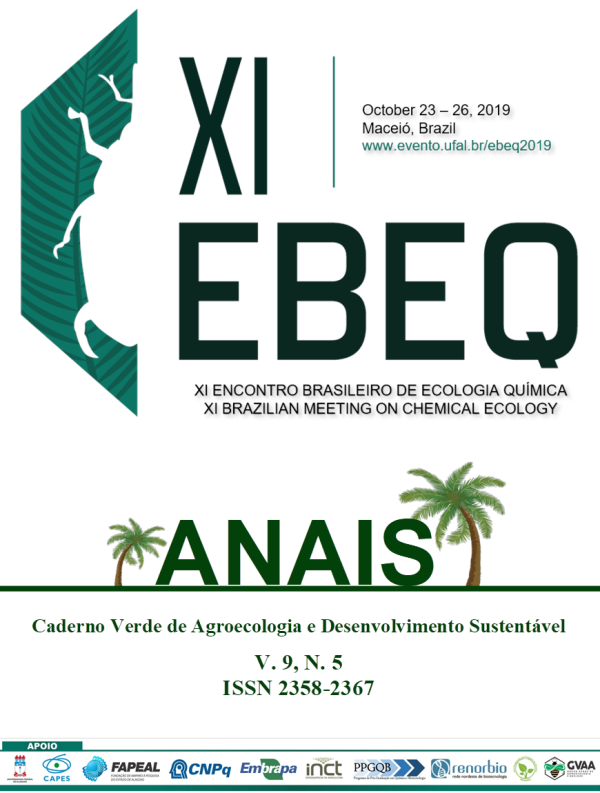Diatraea saccharalis (FABRICIUS, 1794) (LEPIDOPTERA: CRAMBIDAE) MALE RESPONSES IN WIND TUNNEL
Palavras-chave:
SUGAR CANE, BORER, PEST MANAGEMENT, PHEROMONES, ATTRACTIONResumo
In order to determine the attraction of D. saccharalis males in wind tunnel, two bioassays were conducted on one- and two-days old (1 d.o. and 2 d.o.) virgin adults. The tests were carried out under controlled conditions 25°C, 50% HR, wind speed 0.30 m/s and inverted photoperiod 12h L:12h D, between the fifth and twelfth hour from the beginning of the scotophase. In the first trial (E1), male response to virgin females was evaluated, 15 males were tested by placing five females per age in a plastic cage. Each male was observed for 10 minutes, recording the response to the stimulus released by the females, Female free control was used (n = 10 for each male age). For the second trial (E2) male response to concentrated sex glands in n-hexane (16 female glands in average per ml) was evaluated. Thirty males were evaluated per treatment, applying 10µl of extract on a filter paper for each evaluation, and the response time to the stimulus and their behavior inside the tunnel was recorded during five minutes. Treatments for both trials corresponded to T1 (♂ 2 d.o. ♀ 1 d.o.), T2 (♂ 2 d.o. ♀ 2 d.o.), T3 (♂ 1 d.o. ♀ 2 d.o.) and T4 (♂ 1 d.o. ♀ 1 d.o.). Data analysis was carried out under generalized linear models, using the binomial distribution; the LSD-Fisher with Bonferroni correction was performed; the association between treatments and displacement inside the tunnel was evaluated using the chi-square test. The results obtained indicate that, for Trial one (E1), T4 showed the highest number of males that responded to the stimulus (80%), followed by T3 (40%). For Trial two (E2), the highest male response corresponded to T4 and T3 (63,33 % and 56,67%, respectively). The chi-square test showed no association between treatments and displacement in the tunnel. Extracts that presented the greatest response stimulus in males are being identified to determine the sex pheromone composition for D. saccharalis colombian populations.Referências
BARRERA G. P; et al., (2017) Identification of Diatraea spp. (Lepidoptera: Crambidae) based on cytochrome oxidase II. PLoS ONE 12(9): e0184053. https://doi.org/10.1371/ journal.pone.0184053..
BARRETO-TRIANA, N.; et al., (2018). Evaluation of two commercial pheromones for male capture of Diatraea saccharalis (Lepidoptera: Crambidae) in sugarcane crops in Colombia. Resúmenes 5th Congress of the Latin American Association of Chemical Ecology (ALAEQ). Valparaíso. Chile. p.: 143.
BLASSIOLI-MORAES, M.C.; et al., (2017). Identification and field evaluation of a new blend of the sex pheromone of Hypsipyla grandella. PESQUISA AGROPECUARIA BRASILEIRA, v. 52, p. 977-986.
CARVAJAL A. et al., (2018). Aspectos Generales del Sector Agroindustrial de la caña 2017-2018. Informe anual 2017-2018. Cali. Colombia.
ICA - Instituto Colombiano Agropecuario. (2017). Resolución 00017848 del 20 diciembre de 2017. “Por medio de la cual se establecen medidas fitosanitarias en el cultivo de caña de azúcar (Saccharum spp. L) en el territorio nacional para la vigilancia y control de las especies barrenadoras del tallo del género Diatraea Guilding”. 10 p.
PALACIO, A. M. P., et al., (2010). Geographic variation of sex pheromone and mitochondrial DNA in Diatraea saccharalis (Fab., 1794) (Lepidoptera: Crambidae). Journal of insect physiology, 56(11), 1624-1630
SANDOVAL, Y.P; et al., (2015). Distribución de especies y enemigos naturales de Diatraea spp. (Lepidoptera: Crambidae) en caña panelera Saccharum officinarum L. en Colombia. Resúmenes, Congreso Colombiano de Entomología. 42, Congreso SOCOLEN. Medellín, Antioquia, 29 a 31 de julio de 2015. Sociedad Colombiana de Entomología - SOCOLEN. Medellín, Colombia. p.: 691.
SANDOVAL-CÁCERES, Y. P et al., (2018). Diatraea saccharalis (Fabricius, 1794) (Lepidoptera: Crambidae) sexual behavior and reproductive success in laboratory. Resúmenes 5th Congress of the Latin American Association of Chemical Ecology (ALAEQ). Valparaíso. Chile. p.: 143.
SOLIS, M. A.; METZ, M. A. (2016). An illustrated guide to the identification of the known species of Diatraea Guilding (Lepidoptera, Crambidae, Crambinae) based on genitalia. ZooKeys 565: 73–121.
VARGAS O., G. A. (2015). Retos y oportunidades en el manejo de los barrenadores del tallo, Diatraea spp. Cali, Cenicaña. 6 p. (Serie divulgativa No. 17).
VARGAS, G.; POSADA, C. (2013). Análisis económico del control biológico de Diatraea spp. Documento de trabajo No. 727. Santiago de Cali.
Downloads
Publicado
Como Citar
Edição
Seção
Licença
Termo de cessão de direitos autorias
Esta é uma revista de acesso livre, em que, utiliza o termo de cessão seguindo a lei nº 9.610/1998, que altera, atualiza e consolida a legislação sobre direitos autorais no Brasil.
O(s) autor(es) doravante designado(s) CEDENTE, por meio desta, publica a OBRA no Caderno Verde de Agroecologia e Desenvolvimento Sustentável, representada pelo Grupo Verde de Agroecologia e Abelhas (GVAA), estabelecida na Rua Vicente Alves da Silva, 101, Bairro Petrópolis, Cidade de Pombal, Paraíba, Brasil. Caixa Postal 54 CEP 58840-000 doravante designada CESSIONÁRIA, nas condições descritas a seguir:
O CEDENTE declara que é (são) autor(es) e titular(es) da propriedade dos direitos autorais da OBRA submetida.
O CEDENTE declara que a OBRA não infringe direitos autorais e/ou outros direitos de propriedade de terceiros, que a divulgação de imagens (caso as mesmas existam) foi autorizada e que assume integral responsabilidade moral e/ou patrimonial, pelo seu conteúdo, perante terceiros.
O CEDENTE mantêm os direitos autorais e concedem à revista o direito de divulgação da OBRA, com o trabalho simultaneamente licenciado sob a Licença Creative Commons do tipo atribuição CC-BY.
O CEDENTE têm autorização para distribuição não-exclusiva da versão do trabalho publicada nesta revista.
O CEDENTE têm permissão e são estimulados a publicar e distribuir seu trabalho online (ex.: em repositórios institucionais ou na sua página pessoal) a qualquer ponto antes ou durante o processo editorial, já que isso pode gerar alterações produtivas, bem como aumentar o impacto e a citação do trabalho publicado.










